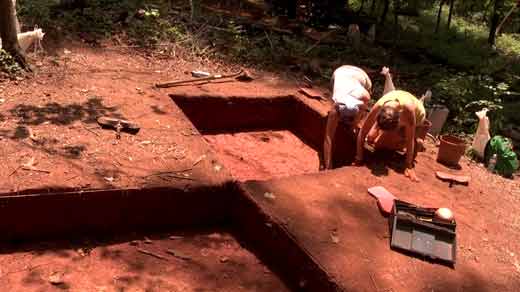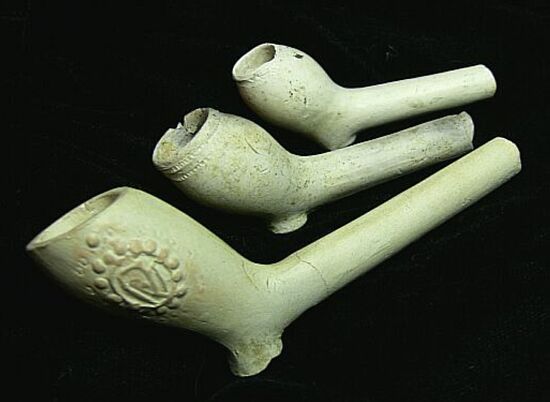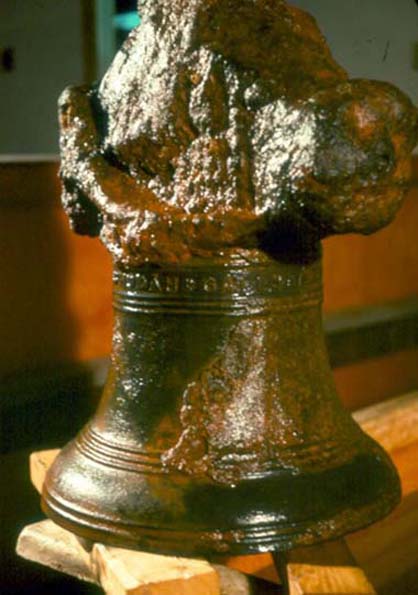 |
| Dr. James Deetz, Master of the Parenthetical Comment |
 |
| Fort Ross in 1828. Outside the wall were the homes of seal hunters brought all the way from the Aleutians, and where the archaeology has been focused. |
Naturally, historical archaeology is defined in contrast to prehistoric archaeology. Unfortunately, this distinction is troublesome. It might seem simple to say that the former implies the archaeology of historical time, while the latter is the archaeology of people and places before there was a historical record. The problem is that "history" as it is commonly perceived prioritizes written history, but culture always has memory. Every culture has at least oral history. Many cultures will have some representational history--Mayan glyphs, southwestern pictograms, Plains hide paintings--yet these are not, by most classifications, within the purview of historical archaeology. This also means that creating a numeric break from prehistory to history will vary from society to society and even from site to site. Thus, another distinction is often made between "pre-contact" and "post-contact"--that is, before and after the coming of European colonizers; the term "Pre-Columbian," referring of course to Columbus, is often used to generalize pre-contact. "Contact" was in most cases a huge, and often catastrophic event for indigenous cultures. However, this distinction gives that moment premier priority, a distinction that might not be shared by that culture. Do Arawaks consider the coming of Columbus the single most important event in their culture, the Hawaiians the arrival of Captain Cook, the Powhatans the coming of John Smith?
 |
| Dig me, map me, call me a culture |
Much richer storytelling can be done with historical archaeology, and not just because there's a documentary record to go with it. The method of historical archaeology, the genius of it in my mind, is to not assume that history is right or complete. How does what is found in the ground compare and contrast with the written record? Did events unfold the way that the accounts tell, and if not, what is the fuller picture? There are two parts to this methodology, really. One, historical archaeologists are historians, interpreting the written record from new perspectives that may vary from or even contradict prior readings. Two, they are archaeologists, seeing if there is evidence of their interpretation, or if the data forces a different interpretation. It's forensics, from a certain point of view. To me, this methodology not only creates fuller past cultures but also better "science," because both the historical and the archaeological data must match for a hypothesis to be accepted.
 |
| We love square holes: archaeology at Jefferson's Monticello |
Historical archaeology also has a common approach, which is to document those who are otherwise largely undocumented. The quote "History is written by the victors" is attributed to Winston Churchill, and it's true. In real terms, this usually means male, white, and wealthy. It's no joke when archaeology is called the "the science of trash," and everybody leaves trash. Thus, archaeology can bring to light the lives of the poor, the enslaved...the losers. It can reveal the lives of women. It can also, and perhaps especially, show the interactions, the trading of things and ideas, between the colonizer and the colonized. Historical archaeology digs up, quite literally, what has fallen through the cracks in the floor.
 |
| You can tell a lot about people by what they smoke |
With due respect, I must begin my cases with Jim's In Small Things Forgotten, the single most important book in historical archaeology. Deetz used a variety of sometimes literally small items to make big archaeological statements. One example is clay tobacco pipes, the disposable means by which most people smoked before they started rolling their own. These are naturally usually found broken, and while the decorated bowls can point to a place of manufacture, the stems, by a nice coincidence with industrial progress, tended to have a thinner bore by about 1/64th of an inch every 30 to 50 years from 1620 to 1800. Thus, clay pipes could be used to establish a rough date for a site and, perhaps, how long it was occupied. My favorite example is gravestones. Deetz observed that the oldest colonial grave markers were decorated with a "winged death's head, with blank eyes and a grinning visage." These were gradually replaced with cherubs and, after that, "a willow tree overhanging a pedestaled urn." These changes in ceremonial taste connect to phases in American ecclesiastical history. The winged death's head corresponds with the rather grim view of the afterlife held by the early Puritans. The more cheerful cherubs reflect a stress on the possibility of resurrection over the inevitability of mortality, as would have been preached by 18th century American theologians such as Jonathan Edwards. The willows and urns, finally, mark not "here lies the body of" but "in memory of," from internment to eulogy, matching "the rise of less emotional, more intellectual religions, such as Unitarianism and Methodism." These are just a few of the ways that Jim showed students like me that those objects that might be overlooked could be used to tell compelling and perhaps important stories.
 |
| Three Saints Bay today (pic by Miller Freeman): helluva view for a dig, eh? |
Intending fully to toot my own horn, I will turn to Three Saints Bay. I just dug out my Rite-in-the-Rain journals from 1990 and had an enjoyable traipse through the wet and wild field camp. I also unpacked my old leader Aron Crowell's Archaeology and the Capitalist World System: A Study from Russian America (not a cheap read). For years promyshlenniki--Russian trappers/huntsmen/traders--had been working east across Siberia, feeding fashion demand for sable, marten, and ermine furs. They reached the Pacific in 1649 and established the port of Okhost. When they took to the ocean towards Alaska, both their prey and their methods changed: Sea otter pelts became du jour, and the Russians realized that the native Aleuts with their traditional methods were much better at the hunting than they were with with their noisy rifles. The natural imperialist solution was to enslave the Aleuts. The promyshlenniki and their slave labor progressed up the Aleutian chain through the 18th century. In the 1760's they reached Kodiak Island, and in 1784 merchant and mariner Grigorii Shelikhov founded the Three Saints Bay colony as a base for industrial fur operations. The native Alutiiq (also known as Qikertarmiut or Koniag) were "pacified" and forced into labor, suffering inevitably from European disease and losing many of their traditions to acculturation. The settlement was hit by an earthquake and tsunami in 1788. More importantly, in 1791 Aleksander Baranov took over operations in the area and established Pavlovskaya, what is the modern day town of Kodiak, and shifted the base of Alaskan operations to its better harbor and more defensible position. Three Saints dwindled until it was abandoned some time in the early 1800's.
 |
| 1826 engraving of Three Saints Bay, based on a painting done on site by Voronin in 1790 |
The people of Three Saints had a strict class system, which is shown in a variety of ways in the material culture and thus the archaeological record. At the top were the Russian captain and his officers, living in a large wooden cabin and benefiting the most when the few supply ships came in. At the bottom were the Alutiiq, living much as they had before in semi-subterranean barabaras and still largely using traditional tools, often made out of ground slate. In the middle were the promyshlenniki. Our working hypothesis was that this working class was at least as likely to use native lifeways as they were to maintain their Russian identity. The brief answer is that we were correct. Most of the 1991 field season was focused on a single structure, "Structure 3 (S-3)," a three-room "dugout" probably occupied by promyshlenniki but bearing at least a passing resemblance to a barabara. Inside we found both Russian import artifacts like iron nails, porcelain sherds, and trade beads (lots of trade beads) and Alutiiq artifacts, including a fabulous (cuz I found it) 7" ground slate ulu knife.
We also found, somewhat puzzling at the time, several dense clusters of seeds, sometimes charred, especially in and around S-3's hearths. These for me became the subject of year's worth of lab work. What I determined was that the vast majority of them were salmonberry, ubiquitous in coastal Alaska, and most of the rest were elderberry. The salmonberry was easy enough to imagine in use, being in the same family as blackberries and raspberries, but the elderberry was harder to explain, as they are poisonous when eaten raw. My idea was that both kinds of berries were boiled and strained, and, while they could have just been made into juice, it seemed reasonable that they were also made into liquor. This hypothesis was corroborated in the historical record and further supported cultural exchange between the Russian working class and the Alutiiq: Gavriil Davydov, who toured Russian America just after the turn of the 19th century, noted that the Alutiiq "did get drunk before the Russians came, on the fermented juice of raspberries and bilberries. The Russians distill a very good vodka from this--but a barrel of berries gives only a bucket of vodka." In short, my contribution to the literature of historical archaeology was that among the ways that colonizers made a foreign, isolated environment more comfortable was by adopting and adapting native hooch. What can I say? I was a booze geek even at 21 years old.
 |
| Pistol and shot, recovered and restored from the wreck of the Whydah Gally |
Finally, the pirates. I want to give a few words to the Whydah Gally, but I'll be brief here, as a rehash of the famous shipwreck isn't really necessary for my audience. Just to introduce... 1715: Merchants in London commission a 300 ton, 102' galley, heavily armed and fast, for use in the Atlantic slave trade. 1716: On its maiden voyage, the Whydah completes two sides of the triangle trade, exchanging trade goods for men in West Africa who are in turn exchanged for sugar, rum, precious metals and other goods in the Caribbean. 1717: Near the Bahamas, the Whydah is intercepted and taken by the pirate "Black Sam" Bellamy, who makes Whydah his new flagship and further arms an already imposing vessel. Bellamy cruises up the Eastern Seaboard in search of prizes. Only a few months later, the Whydah and her consort the sloop Marianne are caught by a strong nor'easter off Cape Cod. The Whydah loses her mainmast, capsizes, and is smashed to pieces off what is now Marconi Beach, Massachusetts. From both ships, out of nearly 150 men, only seven survive. 1984: The Whydah is found by Barry Clifford, who begins ongoing excavations of the only confirmed pirate shipwreck. 2007: The museum exhibit "Real Pirates," under the auspices of the National Geographic, begins to tour, and a permanent museum is and headquarters is established in Provincetown, Massachusetts.
 |
| You can tell a ship by its bell |
 |
| Real pirates of the Whydah, as envisioned by painter Gregory Manchess: L-R: Hendrick Quintor, John King, Sam Bellamy and John Julian |
And there are so many stories to be told. Forget, if you can (and I know it's hard), the booty. My third point about the Whydah is that it's not just a pirate ship but a slave ship. La Amistad is famous for her role in history, her Spielberg-ization, and her modern sailing replica. Yet the original La Amistad disappeared into obscurity in the Caribbean, and the only other two archaeological sites of slave ships I can find are the Henrietta Marie (discovered by another "treasure hunter," Mel Fisher) and the Trouvadore. Clifford has been accused of showcasing pirates over slaves; on one hand this is understandable, but on the other hand it isn't entirely true, as there is ample discussion of the ship's original purpose in the "Real Pirates" exhibit. Fourth, there are many small things forgotten that have come up from from the remains of the Whydah. Us dress-up pirates love to, shall we say, accessorize with colorful coats and shiny objects. Although the common tar would have dressed simply and practically, artifacts from the Whydah prove that Golden Era pirates really were the dandies we imagine--buttons, rings, chains, and so on. The material evidence also supports the idea that pirates would rather take a ship by engaging at close quarters rather than damaging their prize with cannonballs. The most common artifacts have been musket balls and bird shot; the pirates meant to harm the crew, not the precious ship and its cargo. Finally, the Whydah has given us some great characters, the likes of which wouldn't even rate a footnote in a general history book. One is the 11-year-old scalawag John King, who it is said insisted on going on the account when he and his mother were captured, and who is tentatively evidenced by a small, black leather shoe and an adolescent fibula. Another is "Indian" John Julian, half Black and half Miskito. Although not the only African-American in Bellamy's multiracial crew, he was indeed the pilot. He was 'lucky' enough to be one of the Whydah's survivors, but there is historical evidence that he was not only sold into slavery but also eventually executed for killing a bounty hunter pursuing him.
Clearly I could go on and on. Whether they be the colonial dead (Walking Dead prequel?), Russian-American frontiersmen, or half-blood pirates, historical archaeology will always spin fascinating yarns, the likes of which would otherwise go untold. Ask me, and I'll dig again; I know where my trowel is (and where my towel is, if hitchhiking is necessary), and it's sharp. In the mean time, my mind and thus the blog world of Logan will continue to be inspired by both the record on paper and the record in the ground or under the water. I hope you find it at least half as engrossing as I do.

No comments:
Post a Comment